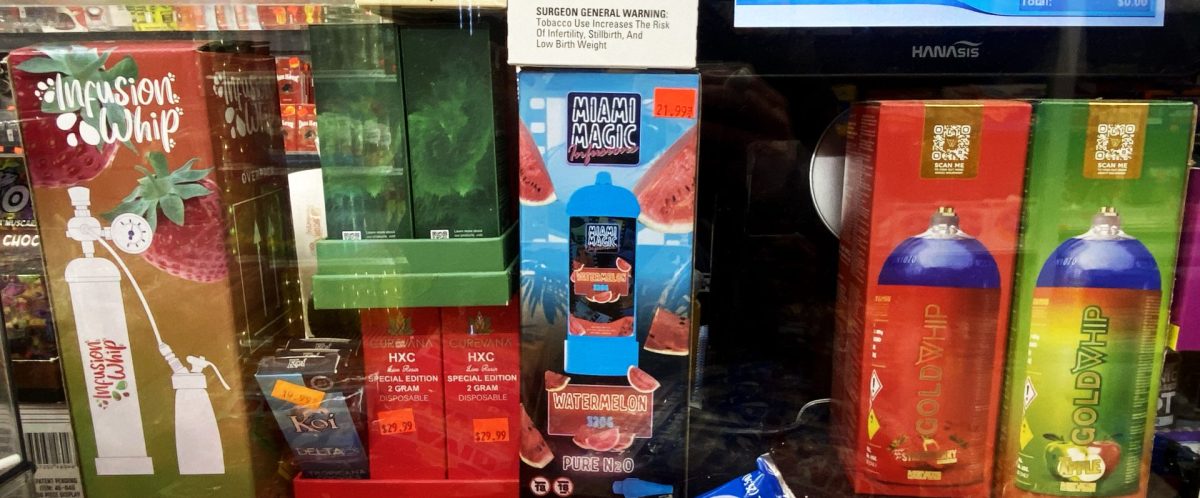Teens and young adults in the United States are risking death to get high as recreational use of nitrous oxide — commonly known as whippits — is “rising rapidly,” according to doctors at the Yale School of Medicine.
Though nitrous is officially used as an oral and surgical anesthetic and as an ingredient in whipped food products, whippit users inhale it from canisters to experience a “short-lived” feeling of “relaxation,” Yale experts said. While whippits, also called “hippie crack,” have been used for centuries, three major factors are driving their recent surge in popularity: their current virality on internet platforms, their widespread accessibility and their new marketing that appeals to young consumers.
“People get a sense that if more people are doing it, it must not be all that bad … when in fact it is,” Geoffrey Durso, a DePaul assistant marketing professor, said.
Experts are concerned about the rising use of whippits because of the extreme health risks associated with them. While overdoses can be deadly to users, even nonfatal incidents can cause brain and nerve damage, among other complications, according to the Alcohol and Drug Foundation.
“I think it’s so dangerous within social networks because there’s an impression that things that are legal are safe,” Austin Lim, a DePaul neuroscience professor, said.
In recent months, content of “influencers, celebrities and teenagers” using whippits began trending on social media platforms, particularly on TikTok. Videos of people inhaling whippits on the app show an instant change in users’ demeanors, as it induces euphoria, numbness, sedation and giddiness, according to the ADF.
Durso said this type of content breeds “a sense of trust” that can lead young consumers to make misguided decisions about using the substance – a risk which led TikTok to ban any videos or searches related to whippits.
“It’s just harder to read science articles than it is to watch TikToks,” Durso said.
In promoting the use of whippits, he said content creators frequently fail to acknowledge the many dangers of using them. Long-term, regular use can induce memory loss, brain and nerve damage, loss of muscle control and disruption to the reproductive system, while a sudden overdose can cause a loss of blood pressure, fainting, heart attack and death, according to the ADF.
“I don’t think that (young people) have the scope or scale to visualize the risks versus the short-term benefits or pleasure they’re getting from the drug,” Lim said.
Unlike other potentially fatal drugs, the Drug Enforcement Administration does not classify nitrous oxide as a controlled substance, meaning that it’s legal to sell and use for its “intended purpose,” according to a report in USA Today. This classification allows nitrous companies to market and sell the substance as a food and beverage ingredient in stores and online. And as there’s no age restriction to purchase it in any state besides New York, the substance is widely accessible to young consumers for illegal recreational use, the report said.
“If it was actually supposed to be marketed as a food product, it would be in a gray stainless steel tube with no colors,” Lim said. “But they come in flavors. Why do you need strawberry nitrous oxide? The companies are intending for young people to be the target audience.”
Last week on the social media app X, singer SZA publicly questioned the intention of the branding nitrous companies are using to promote and package their products, claiming that the substance is being “mass marketed” to young consumers. For example, the company Galaxy Gas offers many flavors of nitrous (such as “Mango Smoothie” and “Vanilla Cupcake”) and uses different neon colors and prints to package each one.
“Those (flavors) are all targeted by design. It’s meant to influence people to feel like it’s fun and hide potential health concerns,” Durso said.
Galaxy Gas’ website displays an automatic pop-up warning to users, stating that its products are meant for “culinary food use only,” and that misuse is “unlawful.” In a statement to The DePaulia, the company also added that its owners are “deeply concerned about the recent news reports and social media posts of individuals illegally misusing (their) products.”
In light of the potentially fatal consequences of using whippits, Lim said that initiatives to spread information about the substance’s risks need to catch up to the speed of its rising popularity.
“The fact that this product is becoming so popular so quickly isn’t giving any of those slow-moving institutions like the government or NIDA (the National Institute of Drug Abuse) any chance to really do something about health messaging,” Lim said. “So people aren’t fully aware of the risks because they’re not told about it from the beginning.”
Durso said he hoped that the national popularity and extreme risks of whippits will motivate legislators nationwide to enact stricter laws to regulate the substance.
“If there’s no (age) restrictions now and there continues to be news coverage about the consequences, it sounds like something that might see bipartisan legislation,” Durso said. “ It needs to have more guardrails in place and there needs to be regulation.”
Related Stories:
- Cannabis studies minor offers social justice perspective
- Illinois Senate works towards cannabis reform, equity concerns remain
- Opinion: Legal protection for cannabis needs to be extended to hiring practices
Support Student Journalism!
The DePaulia is DePaul University’s award-winning, editorially independent student newspaper. Since 1923, student journalists have produced high-quality, on-the-ground reporting that informs our campus and city.
We rely on reader support to keep doing what we do. Donations are tax deductible through DePaul's giving page.


